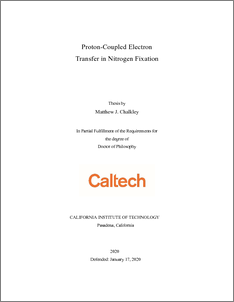Abstract
This thesis focuses on the management of protons and electrons in the formation of X−H bonds. In our pursuit of better understanding this process, we have been particularly interested in the nitrogen fixation reaction (N2-to-NH3) because of the high number of protons and electrons involved in this conversion (6) and the significant difficulty of functionalizing N2. The first chapter introduces the important themes of this thesis: (i) multiple bonding, (ii) proton-coupled electron transfer, (iii) overpotential in N2 fixation, and (iv) selectivity in N2 fixation. The second chapter discusses the bonding of an iron complex with a small molecule (NO) and how this bonding is key to activating the small molecule for reactivity. The third chapter looks at how employing a new proton and electron source allows an Fe catalyst to achieve improved selectivity and turnover number for the reduction of N2 to NH3 despite a lowered overpotential relative to previous reactions. It also raises the hypothesis that this is possible due to proton-coupled electron transfer mediated by a metallocene. The fourth chapter studies the effect of acid strength on N2 fixation selectivity and demonstrates circumstantial evidence for the involvement of a decamethylcobaltocene (Cp*2Co) in the formation of N−H bonds via proton-coupled electron transfer. It also highlights how the addition of co-catalytic [Cp*2Co]+ to electrochemical experiments with our Fe catalyst enabled truly electrocatalytic N2 fixation for the first time. The fifth chapter provides both atomistic detail on the protonation reactivity of Cp*2Co and experimentally verifies the prediction that this species would be an extremely strong hydrogen-atom donor. It also develops a conceptual framework to explain the uniquely weak C−H bonds both homolytic and heterolytic that result from metallocene protonation and discusses their potential to play a role in not only the hydrogen evolution reaction (HER), but also the N2 fixation reaction. In the final chapter, we develop a synthetic route to a base appended cobaltocene. We demonstrate that this second-generation cobaltocene can, unlike the first generation, serve as a net hydrogen-atom donor under electrocatalytic conditions. As a demonstration of the utility of this, we use the base-appended cobaltocene for the selective, proton-coupled reduction of ketones to pinacols via a rate-determing concerted proton-electron transfer.
| Item Type: | Thesis (Dissertation (Ph.D.)) |
|---|
| Subject Keywords: | Proton-coupled electron transfer, nitrogen fixation, electrocatalysis |
|---|
| Degree Grantor: | California Institute of Technology |
|---|
| Division: | Chemistry and Chemical Engineering |
|---|
| Major Option: | Chemistry |
|---|
| Awards: | The Herbert Newby McCoy Award, 2020. |
|---|
| Thesis Availability: | Public (worldwide access) |
|---|
| Research Advisor(s): | |
|---|
| Group: | Resnick Sustainability Institute |
|---|
| Thesis Committee: | - Agapie, Theodor (chair)
- Gray, Harry B.
- Miller, Thomas F.
- Peters, Jonas C.
|
|---|
| Defense Date: | 17 January 2020 |
|---|
| Funders: | | Funding Agency | Grant Number |
|---|
| NIH | GM070757 | | Department of Energy (DOE) | 0235302 |
|
|---|
| Record Number: | CaltechTHESIS:02052020-203503014 |
|---|
| Persistent URL: | https://resolver.caltech.edu/CaltechTHESIS:02052020-203503014 |
|---|
| DOI: | 10.7907/FE9D-9K14 |
|---|
| Related URLs: | |
|---|
| ORCID: | |
|---|
| Default Usage Policy: | No commercial reproduction, distribution, display or performance rights in this work are provided. |
|---|
| ID Code: | 13634 |
|---|
| Collection: | CaltechTHESIS |
|---|
| Deposited By: |
Matthew Chalkley
|
|---|
| Deposited On: | 25 Feb 2020 00:37 |
|---|
| Last Modified: | 08 Nov 2023 00:44 |
|---|
![[img]](https://thesis.library.caltech.edu/13634/7.hassmallThumbnailVersion/MatthewJChalkley_Thesis_Final.pdf)  Preview |
|
PDF
- Final Version
See Usage Policy.
17MB |
Repository Staff Only: item control page


